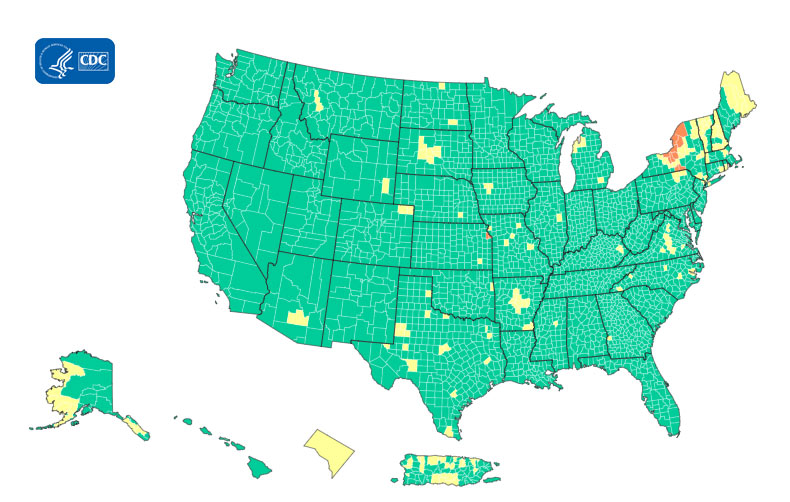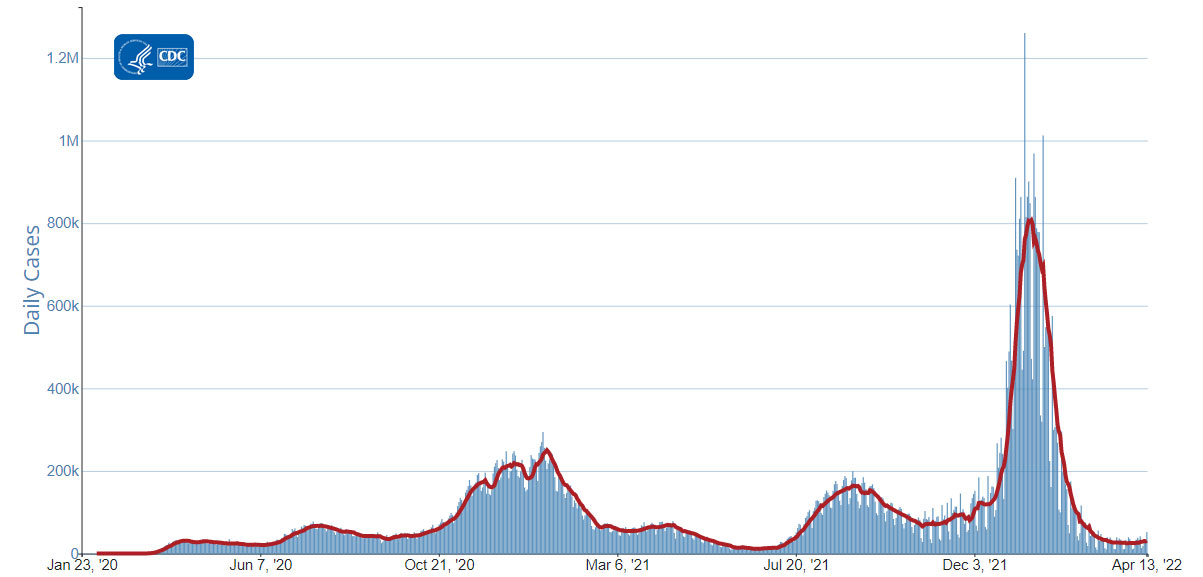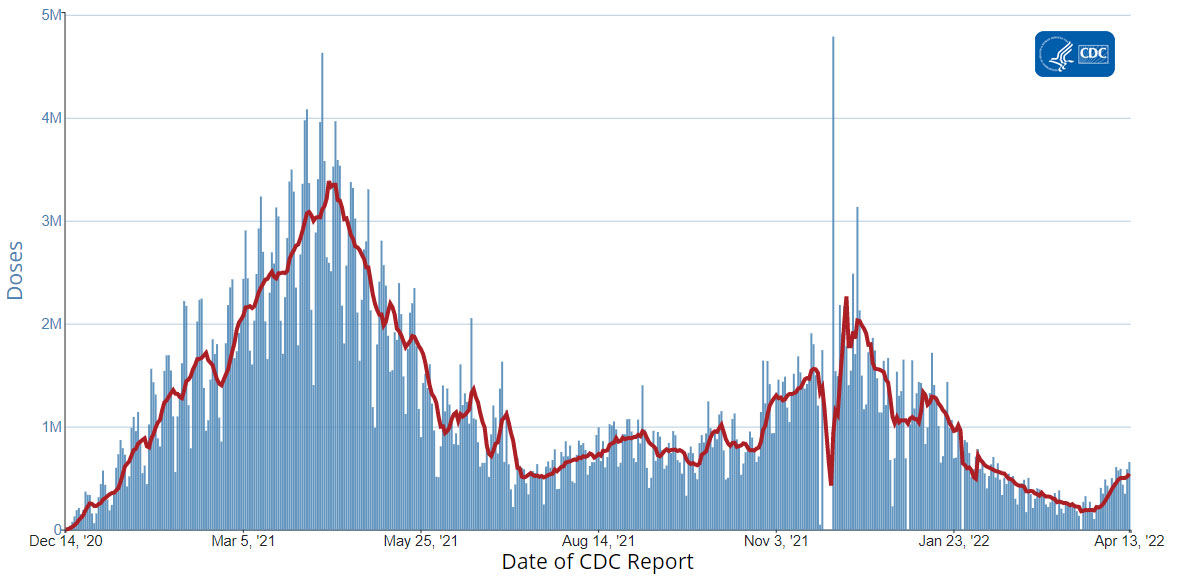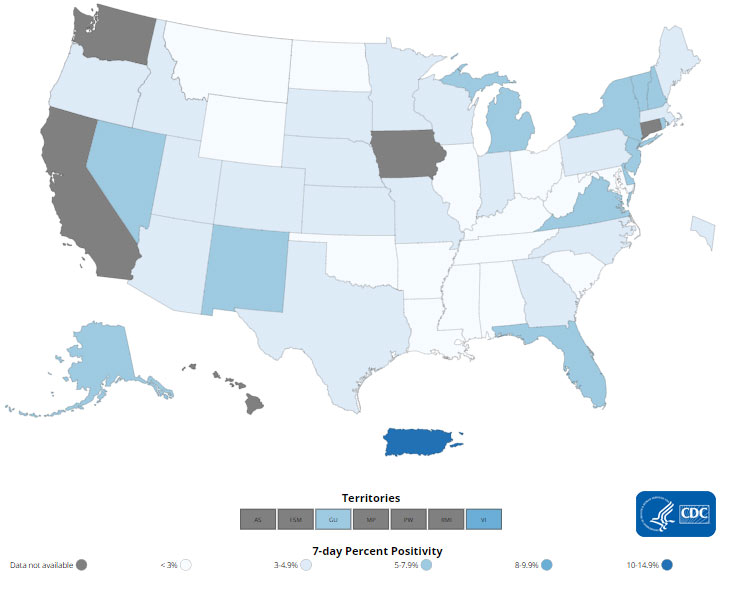Aquatics FAQs
Recommendations for Fully Vaccinated People
COVID-19 Homepage
Get a Jump on Spring
Interpretive Summary for April 15, 2022
Get a Jump on Spring
Throughout the COVID-19 pandemic, many people have delayed or avoided medical care, including routine, urgent, and emergency care. If it’s something you’ve neglected, it’s time to jump back in—consider putting “get a checkup” on top of your to-do list, especially if you’re at risk for heart disease. Regular checkups provide the opportunity to prevent, screen for, and manage chronic conditions, and to get routine vaccinations.
Nearly one million people in the United States have died from COVID-19. People who have heart conditions are more likely to get very sick from COVID-19, and cardiovascular disease is still the leading cause of death in the country. Deaths from cardiovascular diseaseexternal icon have increased during the pandemic.
In addition to seeing your healthcare provider, explore ways to improve and maintain heart health, today and every day. Consider eating a healthy diet, being active, getting enough sleep, avoiding tobacco and excessive drinking, and learning to cope with stress in a healthy way. Simple activities like deep breathing, physical activity, and safely connecting with family, friends, and neighbors can also improve your general well-being and outlook on life. And as always, we encourage everyone to stay up to date on their COVID-19 vaccinations.
*People ages 12 years and older who are moderately or severely immunocompromised have specific COVID-19 vaccine recommendations, including recommendations for a booster dose. Learn more about COVID-19 vaccine recommendations for people who are moderately or severely immunocompromised.
- COVID Data Tracker added U.S. territories to the COVID-19 Community Levels map on the County View tab.
- Effectiveness of COVID-19 mRNA Vaccination in Preventing COVID-19–Associated Hospitalization Among Adults with Previous SARS-CoV-2 Infection — United States, June 2021–February 2022
COVID-19 Community Levels
On February 25, 2022, CDC updated the way it monitors COVID-19’s impact on our communities. Widespread availability of vaccines and testing, advances in treatments, and increasing levels of immunity in the population through vaccination or previous infection have moved the COVID-19 pandemic to a new phase. While we can’t prevent all cases of COVID-19, we can continue to limit the spread and protect those who are most at risk of severe illness.
Currently, there are 14 (0.43%) counties, districts, or territories with a high COVID-19 Community Level, 175 (5.43%) counties with a medium Community Level, and 3,035 (94.14%) counties with a low Community Level. This represents a very slight (−0.19%) decrease in the number of high-level counties, a small (+1.55%) increase in the number of medium-level counties, and a corresponding (−1.36%) decrease in the number of low-level counties. Twenty-two (39.28%) of 56 jurisdictions had no high- or medium-level counties this week.
To check your COVID-19 community level, visit COVID Data Tracker.
Reported Cases
As of April 13, 2022, the current 7-day moving average of daily new cases (31,391) increased 19.1% compared with the previous 7-day moving average (26,357). A total of 80,341,159 COVID-19 cases have been reported in the United States as of April 13, 2022.
CDC Nowcast projections* for the week ending April 9, 2022, estimate the combined national proportion of lineages designated as Omicron to be 100%. There are five lineages designated as Omicron: B.1.1.529, BA.1, BA.1.1, BA.2, and BA.3. COVID Data Tracker shows the proportions of the B.1.1.529 lineage (includes BA.1 and BA.3), the BA.1.1** lineage, and the BA.2 lineage. The predominant Omicron lineage in the United States is BA.2. The national proportion of BA.2 is projected to be 85.9% (95% PI 83.6-87.8%). BA.1.1 is projected to be 13.1% (95% PI 11.3-15.2%) and B.1.1.529 (BA.1 and BA.3) is projected to be 1.0% (95% PI 0.8-1.3%). Omicron is predicted to be 100% in all HHS regions.
80,341,159
Total Cases Reported
80,341,159
Total Cases Reported
31,391
Current 7-Day Average**
31,391
Current 7-Day Average**
26,357
Prior 7-Day Average
26,357
Prior 7-Day Average
19.1%
Change in 7-Day Average since Prior Week
19.1%
Change in 7-Day Average since Prior Week
*The median time from specimen collection to sequence data reporting is about 3 weeks. As a result, weighted estimates for the most recent few weeks may be unstable or unavailable. CDC’s Nowcast is a data projection tool that helps fill this gap by generating timely estimates of variant proportions for variants that are circulating in the United States. View Nowcast estimates on CDC’s COVID Data Tracker website on the Variant Proportions page.
**For national data, the proportion of BA.1.1 is shown separately. For regional data, the proportion of BA.1.1 is also aggregated with B.1.1.529.
***Historical cases are excluded from daily new cases and 7-day average calculations until they are incorporated into the dataset for the applicable date. Of 521,394 historical cases reported retroactively, 4,203 were reported in the current week and 12,690 were reported in the prior week.
Vaccinations
The U.S. COVID-19 Vaccination Program began December 14, 2020. As of April 13, 2022, 567.2 million vaccine doses have been administered in the United States. Overall, about 256.5 million people, or 77.3% of the total U.S. population, have received at least one dose of vaccine. About 218.6 million people, or 65.8% of the total U.S. population, have been fully vaccinated.* Of those fully vaccinated, about 99.0 million people have received a booster dose,** but 49.6% of the total booster-eligible population has not yet received a booster dose. As of April 13, 2022, the 7-day average number of administered vaccine doses reported (by date of CDC report) to CDC per day was 542,444, a 27.7% increase from the previous week.
CDC’s COVID Data Tracker displays vaccination trends by age group, race/ethnicity, and urban/rural status. To see trends by age group and race/ethnicity, visit the Vaccination Demographic Trends tab. To see trends by urban/rural status, visit the COVID-19 Vaccination Equity tab.
567,188,881
Vaccine Doses Administered
567,188,881
Vaccine Doses Administered
256,489,187
People who received at least one dose
256,489,187
People who received at least one dose
218,622,907
People who are fully vaccinated*
218,622,907
People who are fully vaccinated*
77.3%
Percentage of the U.S. population that has received at least one dose
77.3%
Percentage of the U.S. population that has received at least one dose
65.8%
Percentage of the U.S. population that has been fully vaccinated*
65.8%
Percentage of the U.S. population that has been fully vaccinated*
+0.2
Percentage point increase from last week
+0.2
Percentage point increase from last week
+0.1
Percentage point increase from last week
+0.1
Percentage point increase from last week
*Represents the number of people who have received the second dose in a two-dose COVID-19 vaccine series (such as the Pfizer-BioNTech or Moderna vaccines) or one dose of the single-shot Johnson & Johnson’s Janssen vaccine.
**Represents the number of people who are fully vaccinated and have received another dose of COVID-19 vaccine since August 13, 2021. This includes people who received their first additional dose or booster dose.
Hospitalizations
New Hospital Admissions
The current 7-day daily average for April 6–April 12, 2022, was 1,446. This is a 1.3% increase from the prior 7-day average (1,427) from March 29–April 4, 2022.
4,612,454
Total New Admissions
4,612,454
Total New Admissions
1,446
Current 7-Day Average
1,446
Current 7-Day Average
1,427
Prior 7-Day Average
1,427
Prior 7-Day Average
+1.3%
Change in 7-Day Average
+1.3%
Change in 7-Day Average
The start of consistent reporting of hospital admissions data was August 1, 2020.
Daily Trends in Number of New COVID-19 Hospital Admissions in the United States
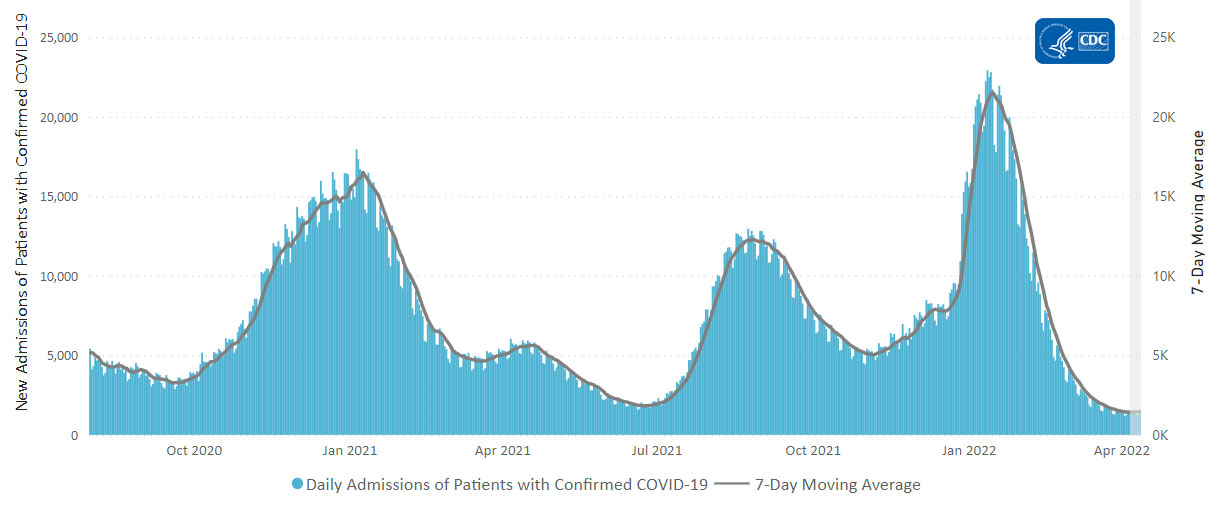
New admissions are pulled from a 10 am EDT snapshot of the HHS Unified Hospital Data – Analytic Dataset. Due to potential reporting delays, data from the most recent 7 days, as noted in the figure above with the grey bar, should be interpreted with caution. Small shifts in historic data may also occur due to changes in the Centers for Medicare & Medicaid Services (CMS) Provider of Services file, which is used to identify the cohort of included hospitals.
COVID-NET: Hospitalization Rates by Vaccination Status in Children Ages 5–11 Years
CDC’s Coronavirus Disease 2019-Associated Hospitalization Surveillance Network (COVID-NET) shows that rates of COVID-19-associated hospitalizations in February 2022 were 2 times as high among unvaccinated children ages 5–11 years compared to adolescents who received a COVID-19 primary vaccination series.*
*Compared to older age groups, children ages 5–11 years have very low rates of hospitalization for any vaccination status. As a result, hospitalization rates by vaccination status for this age group might have more week-to-week variability due to small sample sizes.
Rates of COVID-19-Associated Hospitalizations by Vaccination Status in Children Ages 5–11 Years, January–February 2022
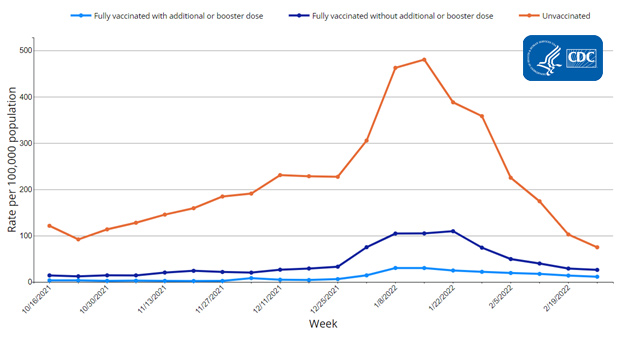
The Coronavirus Disease 2019 (COVID-19)-Associated Hospitalization Surveillance Network (COVID-NET) is an additional source for hospitalization data collected through a network of more than 250 acute-care hospitals in 14 states (representing ~10% of the U.S. population). Detailed data on patient demographics, including race/ethnicity, underlying medical conditions, medical interventions, and clinical outcomes, are collected using a standardized case reporting form.
More COVID-NET DataDeaths
The current 7-day moving average of new deaths (409) has decreased 15.7% compared with the previous 7-day moving average (486). As of April 13, 2022, a total of 984,744 COVID-19 deaths have been reported in the United States.
984,744
Total Deaths Reported
984,744
Total Deaths Reported
409
Current 7-Day Average*
409
Current 7-Day Average*
486
Prior 7-Day Average
486
Prior 7-Day Average
-15.7%
Change in 7-Day Average Since Prior Week
-15.7%
Change in 7-Day Average Since Prior Week
*Historical deaths are excluded from the daily new deaths and 7-day average calculations until they are incorporated into the dataset by their applicable date. Of 21,064 historical deaths reported retroactively, 320 were reported in the current week; and none were reported in the prior week.
Daily Trends in Number of COVID-19 Deaths in the United States Reported to CDC

7-Day moving average
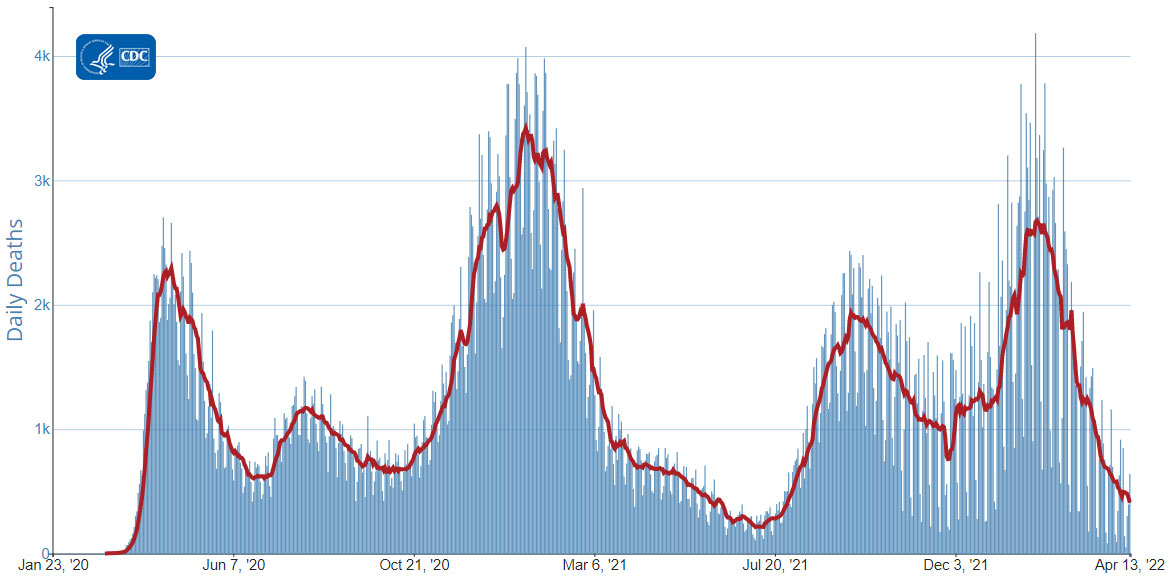 More Death Data
More Death DataTesting
The percentage of COVID-19 NAATs (nucleic acid amplification tests)* that are positive (percent positivity) is increasing in comparison to the previous week. The 7-day average of percent positivity from NAATs is now 4.1%. The 7-day average number of tests reported for April 1-7, 2022 was 684,558, down 14.6% from 801,485 for the prior 7 days.
857,920,235
Total Tests Reported
857,920,235
Total Tests Reported
684,558
7-Day Average Tests Reported
684,558
7-Day Average Tests Reported
4.1%
7-Day Average % Positivity
4.1%
7-Day Average % Positivity
2.8%
Previous 7-Day Average % Positivity
2.8%
Previous 7-Day Average % Positivity
+1.28
Percentage point change in 7-Day Average % Positivity since Prior Week
+1.28
Percentage point change in 7-Day Average % Positivity since Prior Week
*Test for SARS-CoV-2, the virus that causes COVID-19


